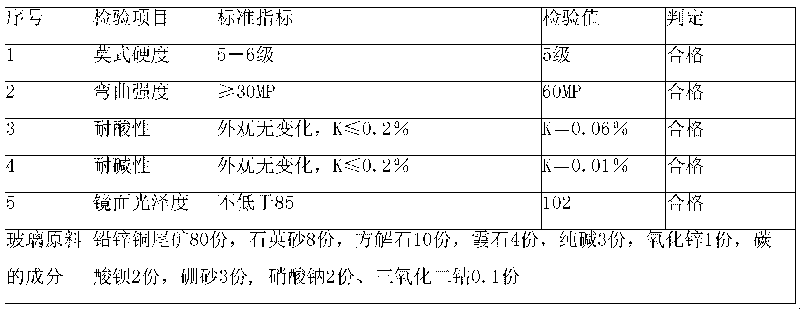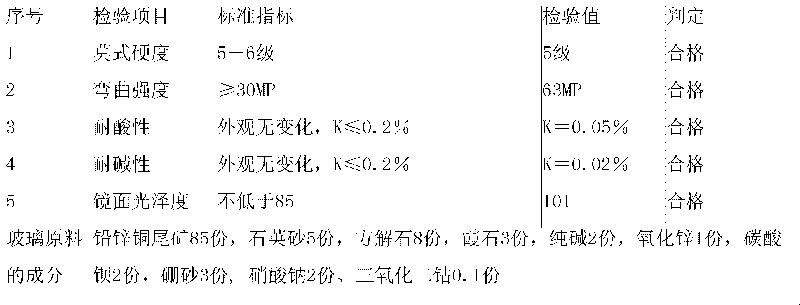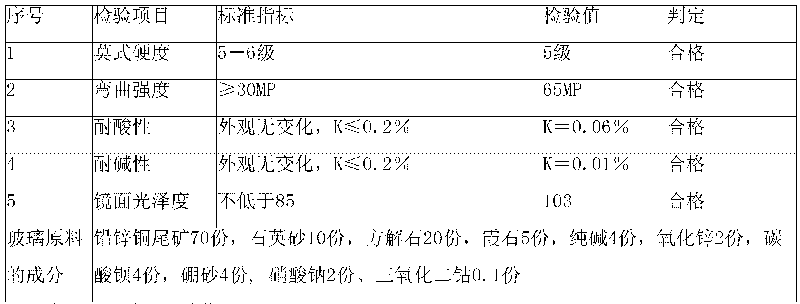Black micro-crystal glass plate manufactured from lead-zinc-copper tailings and manufacturing method thereof
A technology of glass-ceramic and manufacturing method, which is applied in the field of glass-ceramic manufacturing, can solve problems such as high melting temperature, high cost of raw materials, impure black color, etc., and achieve the goal of improving product quality, reducing raw material cost, and mitigating hazards Effect
- Summary
- Abstract
- Description
- Claims
- Application Information
AI Technical Summary
Problems solved by technology
Method used
Image
Examples
Embodiment 1
[0049] First crush and screen the lead-zinc-copper tailings, quartz sand, calcite and nepheline; the fineness of the lead-zinc-copper tailings is above 40 mesh, the fineness of the calcite is above 80 mesh, and the fineness of the quartz sand is 60~ 80 mesh, the fineness of nepheline is 60-80 mesh, and the rest of the raw materials meet the national industry quality inspection standards. The cyanide in the lead-zinc-copper tailings is removed by ion exchange, and then weighed to make a mixture. The weight ratio of raw materials is: 70 parts of lead-zinc-copper tailings, 10 parts of quartz sand, 20 parts of calcite, and 5 parts of limestone, 4 parts of soda ash, 2 parts of zinc oxide, 4 parts of barium carbonate, 4 parts of borax, 2 parts of sodium nitrate, and 0.1 part of dicobalt trioxide. The purity of zinc oxide is 90%, the content of calcium oxide in calcite is 55.5%, the content of silicon oxide in quartz sand is 98%, the content of silicon in nepheline is 54%, and the co...
Embodiment 2
[0052] First crush and screen the lead-zinc-copper tailings, quartz sand, calcite and nepheline. The cyanide in the lead-zinc-copper tailings is removed by ion exchange, and then weighed to make a mixture. The weight ratio of raw materials is: 80 parts of lead-zinc-copper tailings, 8 parts of quartz sand, 10 parts of calcite, and 4 parts of limestone, 3 parts of soda ash, 1 part of zinc oxide, 2 parts of barium carbonate, 3 parts of borax, 2 parts of sodium nitrate, and 0.1 part of dicobalt trioxide. The color of the product is black.
[0053] The above-mentioned glass raw materials were melted in a glass tank furnace with a temperature of 1350° C. for 4 hours. After the melting was completed, the molten glass was directly poured into water to become glass pellets. 13 kg of glass granules were spread flat in a refractory mold with a size of 6000×9000 mm and crystallized in a shuttle kiln fueled by liquefied petroleum gas at a crystallization temperature of 1050°C. Thereby, a...
Embodiment 3
[0055]First crush and screen the lead-zinc-copper tailings, quartz sand, calcite and nepheline. The cyanide in the lead-zinc-copper tailings is removed by ion exchange, and then weighed to make a mixture. The weight ratio of raw materials is: 85 parts of lead-zinc-copper tailings, 5 parts of quartz sand, 8 parts of calcite, and 3 parts of limestone, 2 parts of soda ash, 1 part of zinc oxide, 2 parts of barium carbonate, 3 parts of borax, 2 parts of sodium nitrate, 0.1 part of dicobalt trioxide. The color of the product is black.
[0056] The above-mentioned glass raw materials were melted in a glass tank furnace with a temperature of 1350° C. for 4 hours, and after the melting was completed, the molten glass was directly flowed into water to become glass pellets. Spread 50 kg of glass granules flat in a refractory mold with a size of 6000×9000 mm and carry out crystallization in a shuttle kiln fueled by liquefied petroleum gas at a crystallization temperature of 1050°C. Ther...
PUM
 Login to View More
Login to View More Abstract
Description
Claims
Application Information
 Login to View More
Login to View More - R&D
- Intellectual Property
- Life Sciences
- Materials
- Tech Scout
- Unparalleled Data Quality
- Higher Quality Content
- 60% Fewer Hallucinations
Browse by: Latest US Patents, China's latest patents, Technical Efficacy Thesaurus, Application Domain, Technology Topic, Popular Technical Reports.
© 2025 PatSnap. All rights reserved.Legal|Privacy policy|Modern Slavery Act Transparency Statement|Sitemap|About US| Contact US: help@patsnap.com



